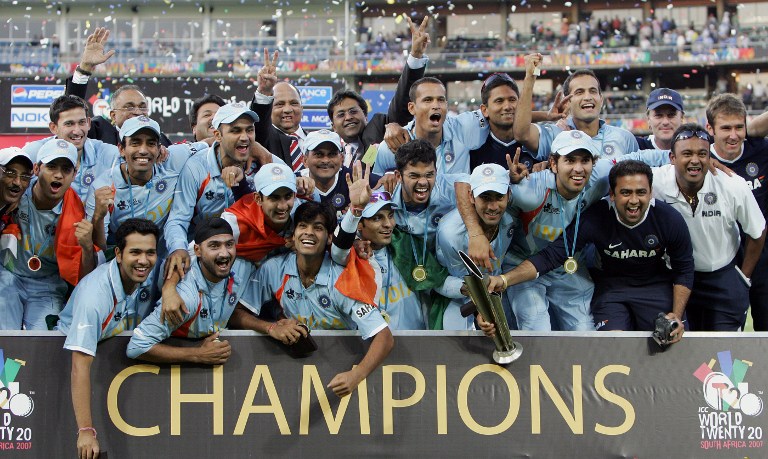2007 T20 World Cup: The Cup that changed cricket forever

The 2007 World T20 started with a lot of apprehensions among cricket fans, but what followed was a joyride of 2 weeks. M.S.Dhoni wrote his name in folklore by winning the cup and the game of cricket has never been the same. From Gayle to Gibbs to Yuvraj, we take a look-back at the first World T20.
"Twenty20? Why not ten-ten or five-five or one-one?"
"We will never play T20"
These were the words of Niranjan Shah, then honorary secretary of the BCCI, back in 2006. The IPL had already started to take shape in the brains of Lalit Modi, but the top brass of the cricketing board whose decisions actually mattered did not seem entirely convinced of the new format. So much so that the BCCI agreed to a world cup in the T20 format only if participation was not obligatory. And even when ICC strong-armed (2011 ODI WC rights were at stake) BCCI into agreeing to participate, they sent a distinctly second choice squad to the tournament. They put Dhoni at the helm of a squad that otherwise lacked quite a few regulars. But after 2007, Indian cricket, just like world cricket, would never be the same again.
The 2007 edition had generated a lot of intrigue before the tournament got underway. In stark contrast to the long and drawn out ODI WC a few months before, this was scheduled to be just two weeks of fast-paced and adrenaline-driven action. In terms of T20 cricket, no one knew what to expect. Only 19 international T20 matches had been played before the first ball in the World cup was bowled.
It must be kept in mind that the tournament was staged at a time when ODI cricket was really struggling for relevance. While many cricket lovers continued to swear their loyalty to the longer format of the game, Test matches were never going to bring in more people and hence definitely lesser revenues. And with ODIs in a pickle, cricket needed a condensed version which would be short enough and packed with action, to compete with the likes of football. Welcome to the world of T20 or the T20 world cup, should we say.
First impressions are always hard to shake off. With the attention and curiosity of the cricketing world firmly fixated on this first-of-its-kind major tournament, South Africa and West Indies locked horns in the first group-A game in an exhilarating encounter. Chris Gayle bludgeoned his way to a scintillating hundred to take West Indies to what seemed a massive 205. But Herschelle Gibbs would respond with a masterpiece of his own, scoring 90 runs to help South Africa overcome a stiff target. It was already as good an advertisement for the format as the organisers could have hoped for. The crowds couldn’t stop pouring in.

As the tournament progressed the thrills and surprises continued to spring up every now and then. Three matches in three days would showcase the brilliant uncertainties this format brought to the table. Zimbabwe would defeat Australia in a cliffhanger with a quick-fire Brendan Taylor 60! Bangladesh would put one across the West Indies. And the mother of all rivalries (Sorry Ashes!) would give us an absolute cracker of a game. India-Pakistan games never fail to disappoint especially at the world cup stage. India were in command after putting 141 on the board, putting Pakistan on the ropes. Pakistan’s top order collapsed with the side needing 39 runs from the last 14 balls. Misbah showed immense composure and a cool head when the win seemed all but elusive as he went berserk taking it to the last ball. But his nerves got to him as he went all hare-brained when the finish line was at touching distance. The match ended in a tie and T20 threw its most unique collection out of the bag: the ‘bowl-out’. It ended in an anti-climax with India winning 3-0, but it was good theatre, and the audience lapped it up without a second thought.
T20 has come a long way since then, and purists argue that all the money in the shortest format is eventually harming the fabric of the game. The forward defensive strokes of key batsmen around the world are probably not as tight as those of previous generations. But T20 has had quite a positive impact on the game as well. A lot of domestic players have better exposure and better lives monetarily as well as socially. The standard of fielding has gone up quite a few notches, in no small measure due to T20. But the biggest effect that T20 has had is in breaking the shackles in the minds of the batsmen. Risk is danger plus opportunity, and T20 has had batsmen around the world recalibrate risk to mean more opportunity than risk. On a clear Durban night, Yuvraj Singh would give us all a taste of the same in one over against Stuart Broad with six 6’s. More batsmen have since discovered the fifth gear which was buried deep in their subconscious covered by doubt and unexplored by ability.
The line-up for the semis was not decided until the final group game. With New Zealand and South Africa having 2 wins under their belt already, India had all to play for when they met South Africa in the final group game needing a win to qualify. South Africa only needed 126 runs to make the cut to the semis after restricting India to 153. But a brilliant RP Singh spell later South Africa finished with only 116, gifting the semis berth to India and New Zealand. All 3 sides finished on equal points with net run rate playing the differentiator.
New Zealand faced Pakistan in the first semi-final. Umar Gul showcased all his death bowling skills to put in match-defining figures of 3/15. In the cauldron of a World cup semi-final, it was pure gold. The ever-unpredictable Pakistani batting line-up cantered to victory in great style thanks to an Imran Nazir 59. They would face the winner of the other semi between India and Australia.

Yuvraj Singh would again be the go-to guy for India, with a destructive 70-off-30 knock. While the Australian stalwarts Hayden, Gilchrist and Symonds all contributed with the bat, the Aussies fell short as Harbhajan and Sreesanth performed heroics with the ball. And this brought to us to the stuff of dreams – an India vs. Pak final. The ICC had struck gold with its very first World T20 venture.
The arch rivals did not disappoint. They put up a show for the ages. India batted first and Gambhir anchored the innings with a masterful half century. Rohit Sharma finished with a sparkling cameo to propel India to a solid, if not threatening, 157. In a high-pressure India Pakistan final of a world cup, it looked to be enough. And sixteen overs into the chase, it definitely seemed so. Pakistan needed 54 from four overs to win. And then it was the Misbah show, yet again. In 15 minutes of nerveless batting, he brought the equation to six from four. The only catch? Pakistan were nine wickets down. Joginder Sharma held the ball(the first exhibit of Dhoni’s luck or pluck – people argue both ways – in crunch moments) and bowled a harmless length ball and Misbah did a Misbah – pulled out an atrocious scoop hitting it right down Sreesanth’s throat and India were the champions! Dhoni’s boys had excelled in the examination that the ‘men’ were reluctant to take.
Watching Misbah slump right in the middle of the pitch as Sreesanth settled under the ball was one of the most iconic images of the World Cup. Sport captures human emotions in their most raw expression and this was one of those moments. It was clear by the end of the tournament that this was not a fun party or a side show as many thought it would be. The tournament caught the fancy of the players and the administrators the world over. For the health of the format, it was perfect in a way that India won the inaugural edition. BCCI might be all the many bad things cricket lovers accuse it of being. But it also was astute in its administrative prowess and quest for money. Armed with the evidence of the successful inaugural World T20, the BCCI threw its entire financial and administrative muscle behind the IPL. And a few months later, in front of a packed crowd at the Eden gardens, Brendon McCullum did to the IPL what Gayle did to the World T20. And for better or worse, cricket, as we knew it, had changed forever.

Comments
Sign up or log in to your account to leave comments and reactions
0 Comments